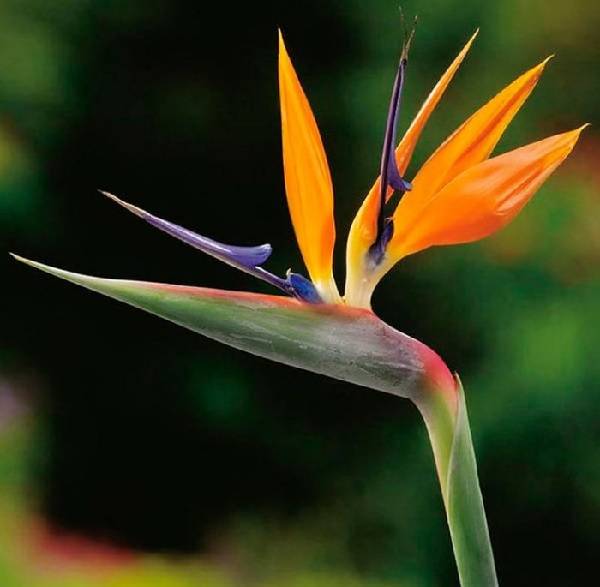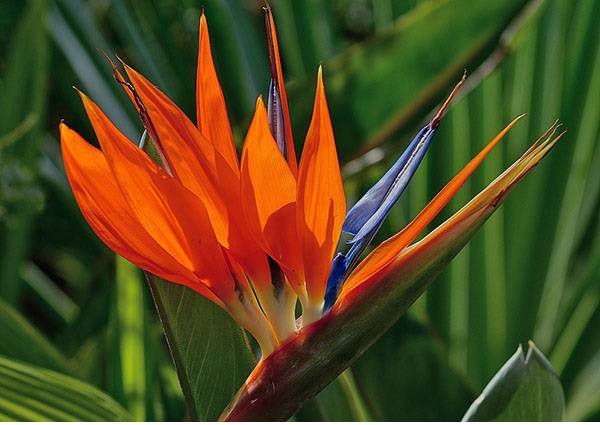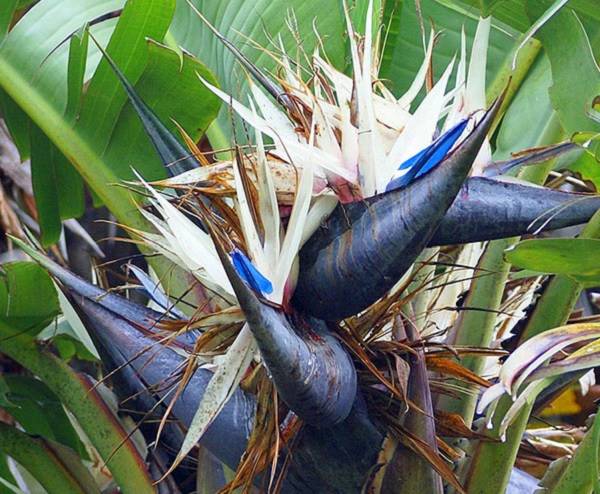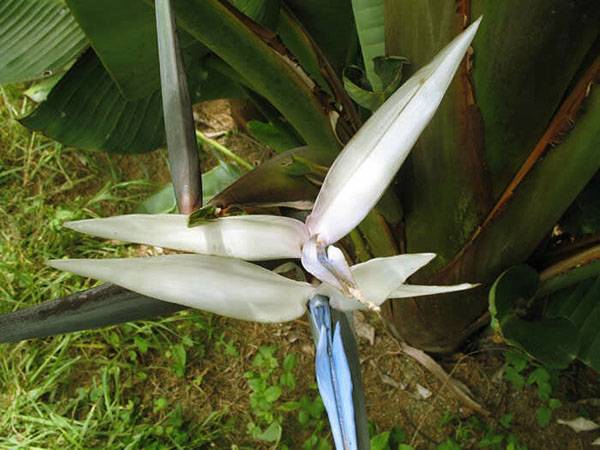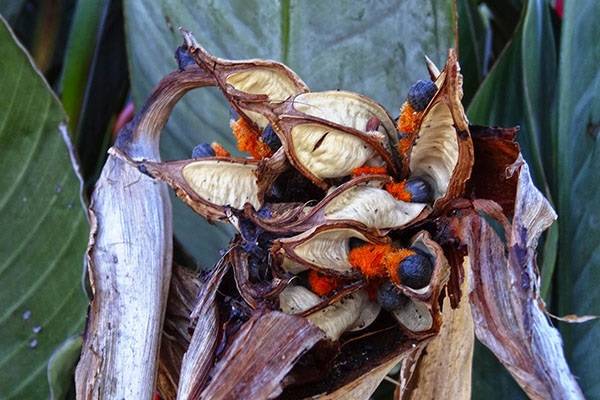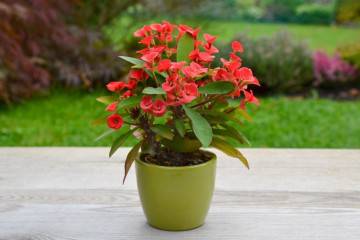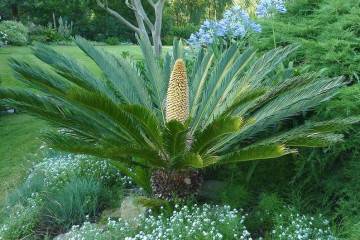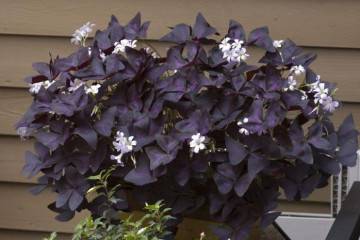Strelitzia flower - how to grow and care
Content:
One of the most unusual plants found in South Africa is Strelitzia, a flower that resembles a tropical bird. In many respects, these are unique perennials, which only relatively recently became widespread outside their natural habitat.
Strelitzia - what is this flower
This plant belongs to the Strelitziaceae family. It cannot be called numerous, but nevertheless in nature there are four of its varieties, each of which is quite spectacular.
Brief description and history of origin
With tough leaves and brightly colored buds, this plant was unlike any other plant known to European colonists. It is sometimes said that strelitzia is a bird of paradise, since it is precisely such associations that this plant causes.
From the point of view of botany, the arrow is an evergreen flower. This is a perennial, which has a powerful root system, ideally adapted to conditions of lack of moisture. At the same time, its aboveground part is also well developed and quite powerful. The leaves are banana-shaped and large in size. But with a lack of moisture, they can significantly decrease. They are almost always covered with a waxy coating. As for the flowers, the strelitzia plant boasts unusual large inflorescences that combine up to seven brightly colored flowers.
In the wild, almost all strelitzia are found in sunny areas, most often these are dry plateaus, but some feel good in diffused shade under large African trees.
As for the history of their selection, at first these plants were cultivated by English colonists, and then they came to Europe.
Varieties of indoor plants with names
All available varieties of strelitzia look quite interesting and impressive, so the choice depends only on personal preference.
Royal Strelitzia (Strelitzia reginae)
This variety was discovered first. Strelitzia royal not in vain received such a name, it really looks very impressive.
The Latin name of the plant is Strelitzia reginae.It is grown not only outdoors, but in pots, and quite successfully. Even if such a strelitzia grows at home, it can reach a height of 1-1.5 m. Its leaves are oval in shape, their width is on average 30 cm. Characteristic features are smooth edges, a smooth surface and a rather powerful and rigid petiole. The flowers are partially covered by bracts of an unsightly greenish hue, but the orange and blue-purple petals themselves look very impressive. The size of one such flower can be up to 15 cm with proper care.
Strelitzia nicolai
In wildlife, this species is found mainly on the ocean coast. This is perhaps the largest strelitzia of all. In the wild, its stems are more appropriately called pillars, since their height can be up to 10 m with a width of about 4 m, and the leaves are simply huge. Sometimes the species Strelitzia nicolai is even confused with palm trees, these plants look so powerful.
By the way, the resemblance to birds is even more pronounced here, because strong winds blow along the coast, and they literally tear apart the stems of the plant, giving them a resemblance to feathers. The flowers on them also look impressive, both due to their large size and due to the unusual purple-blue hue.
Mountain strelitzia (Strelitzia caudata)
This species is also quite large, it is only slightly inferior to the previous one in terms of height and coverage. The lower part of the stem becomes exposed as it grows, which gives it the resemblance to palms and bananas. But you can recognize this variety by its characteristic flowers with blue and white petals.
Strelitzia reed (Strelitzia juncea)
This potted strelitzia takes root much better than the rest. From the very beginning, it does not differ in its large size. In addition, in the wild, it grows in the east of the country, therefore it is better adapted to its climatic conditions, which means that the flower tolerates temperature changes better.
Strelitzia Augustus, or white strelitzia (Strelitzia alba)
This species is also endangered. However, it is still found in the Cape region. In size, this species is inferior to mountain and royal strelitzia, but surpasses the reed one. A characteristic feature is white flowers.
Growing from seeds at home and care
If a grower is interested in strelitzia, caring for her will not be so difficult, but subject to all the rules.
Illumination and temperature conditions
Indoor strelitzia loves light no less than a plant growing in the wild. But she needs diffused lighting, so it is better to place the container on the east or west window. As for the temperature regime, the plant does not like heat, the best option in summer is up to 25-26 ° С.
Watering rules and humidity
From early spring to October, the plant needs abundant moisture. The air should also be humid, and each leaf should be regularly sprayed with water during the summer. But it is important not to overdo it, since it will not work to grow a healthy plant with rotting roots.
Top dressing and soil quality
If a grower has strelitzia, home care necessarily requires feeding. Both mineral fertilizers and nitrogen (organic) fertilizers are used. But they are brought in only three times a month during April-October.
Flower container size
From the description of the plant, it is clear that its roots are taproots, so the pot needs a deep one, at least 20 cm, or even more. And there must be drainage holes at the bottom.
Pruning and replanting
Properly caring for a flower means cutting and replanting it in a timely manner. At first, the transplant is carried out annually, since the plant will need a larger pot all the time. This procedure is best done in early spring.
Features of flowering plants
Those who brought strelitzia to their home most likely chose the royal variety. It has a particularly beautiful bloom.
A period of activity and rest
The dormant period begins in winter, when the plant perfectly withstands temperatures of 13-14 ° C, which allows it to form buds. Active growth continues from March to November.
Types and forms of a flower
This plant has flowers with stiff petals and not very attractive bracts that look good due to its exotic coloration. Such a bird of paradise will perfectly fit into a modern interior.
Flower reproduction methods
If a grower has a strelitzia - a tropical flower, home care and breeding methods will interest him most of all. As for the second, then most often this is growing from seeds, dividing by side shoots or by dividing the root.
Growing from seeds
It is best to buy seeds from a nursery, as there is more guarantee that they will germinate. In addition, at home, to obtain seeds, it is still necessary to carry out artificial pollination, which is associated with additional labor costs. Seeds are sown in small containers in spring, after having washed them under running water and treated with a growth stimulator.
Reproduction by dividing the bush and side shoots
Most often, we are talking about the division of the roots, which is carried out immediately after the end of flowering and before the active growing season begins. The most important thing here is to carefully divide the root and treat the cut with a fungicide. This also applies to reproduction by lateral shoots. Even a person who is not too experienced in gardening can cope with this task.
Growing problems, diseases and pests
This plant is not too susceptible to disease, and with moderate watering, there should not be any problems, and special preparations can be used against pests.
Much more questions arise with problems such as leaves starting to turn yellow. This usually means either an overabundance of bright light or a lack of watering, so you just need to adjust the mode.
As for the cases when you need to find out why strelitzia does not bloom, everything is a little more complicated. The fact is that flowers can appear only in the fourth year of life, so there is no need to rush. But if they did not appear on the fifth, then you can make the plant bloom only if it is provided with a long dormant period. Then the strelitzia will have time to form the kidneys. This means that in winter it is necessary to reduce not only the frequency of watering, but also the temperature. However, experienced growers say that a dormant period can be provided at any time, if the temperature is maintained.
Of course, you will need to be patient to ensure flowering. But in general, this plant remains decorative even without flowers, and this is one of its most important advantages.
